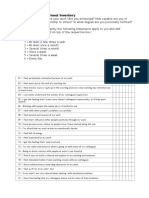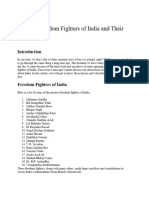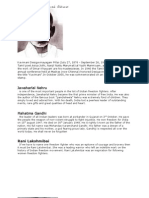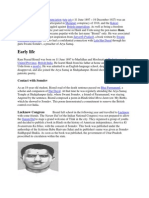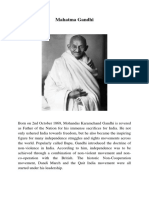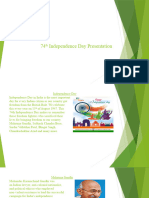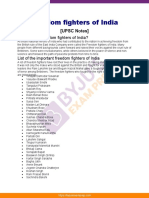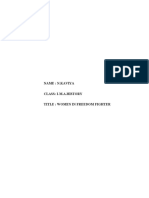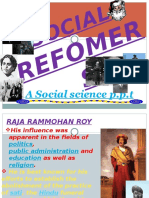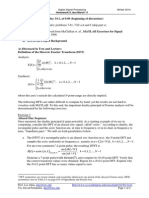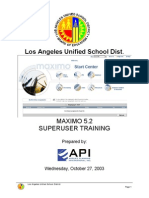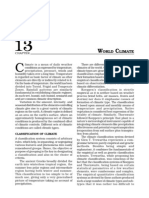0 ratings0% found this document useful (0 votes)
101 viewsSST Activity: Walk Down The Timeline
SST Activity: Walk Down The Timeline
Uploaded by
Sampurna RastogiThe document provides biographical information about 10 prominent Indian freedom fighters: Mahatma Gandhi, Subhash Chandra Bose, Bhagat Singh, Bal Gangadhar Tilak, Lala Lajpat Rai, Pandit Jawaharlal Nehru, Sardar Vallabhbhai Patel, Lal Bahadur Shastri, Chandra Shekhar Azad, and Rani Laxmi Bai. It includes key details about their lives and contributions to India's independence movement. It also includes timelines of important events in the lives of Gandhi, Bose, Shastri, Singh, and Rani Laxmi Bai. The document aims to
Copyright:
© All Rights Reserved
Available Formats
Download as PPTX, PDF, TXT or read online from Scribd
SST Activity: Walk Down The Timeline
SST Activity: Walk Down The Timeline
Uploaded by
Sampurna Rastogi0 ratings0% found this document useful (0 votes)
101 views24 pagesThe document provides biographical information about 10 prominent Indian freedom fighters: Mahatma Gandhi, Subhash Chandra Bose, Bhagat Singh, Bal Gangadhar Tilak, Lala Lajpat Rai, Pandit Jawaharlal Nehru, Sardar Vallabhbhai Patel, Lal Bahadur Shastri, Chandra Shekhar Azad, and Rani Laxmi Bai. It includes key details about their lives and contributions to India's independence movement. It also includes timelines of important events in the lives of Gandhi, Bose, Shastri, Singh, and Rani Laxmi Bai. The document aims to
Original Description:
presentation about the freedom fighters of India along with a chronology of events in their lives
Original Title
Presentation1
Copyright
© © All Rights Reserved
Available Formats
PPTX, PDF, TXT or read online from Scribd
Share this document
Did you find this document useful?
Is this content inappropriate?
The document provides biographical information about 10 prominent Indian freedom fighters: Mahatma Gandhi, Subhash Chandra Bose, Bhagat Singh, Bal Gangadhar Tilak, Lala Lajpat Rai, Pandit Jawaharlal Nehru, Sardar Vallabhbhai Patel, Lal Bahadur Shastri, Chandra Shekhar Azad, and Rani Laxmi Bai. It includes key details about their lives and contributions to India's independence movement. It also includes timelines of important events in the lives of Gandhi, Bose, Shastri, Singh, and Rani Laxmi Bai. The document aims to
Copyright:
© All Rights Reserved
Available Formats
Download as PPTX, PDF, TXT or read online from Scribd
Download as pptx, pdf, or txt
0 ratings0% found this document useful (0 votes)
101 views24 pagesSST Activity: Walk Down The Timeline
SST Activity: Walk Down The Timeline
Uploaded by
Sampurna RastogiThe document provides biographical information about 10 prominent Indian freedom fighters: Mahatma Gandhi, Subhash Chandra Bose, Bhagat Singh, Bal Gangadhar Tilak, Lala Lajpat Rai, Pandit Jawaharlal Nehru, Sardar Vallabhbhai Patel, Lal Bahadur Shastri, Chandra Shekhar Azad, and Rani Laxmi Bai. It includes key details about their lives and contributions to India's independence movement. It also includes timelines of important events in the lives of Gandhi, Bose, Shastri, Singh, and Rani Laxmi Bai. The document aims to
Copyright:
© All Rights Reserved
Available Formats
Download as PPTX, PDF, TXT or read online from Scribd
Download as pptx, pdf, or txt
You are on page 1of 24
SST Activity
Walk Down the Timeline
Our Freedom Fighters:-
1. Mahatma Gandhi
2. Subhash Chandra Bose
3. Shaheed Bhagat Singh
India was free in 1947 from the
British Empire but the country 4. Bal Gangadhar Tilak
lost many men and women who 5. Lala Lajpat Rai
were filled with undaunted 6. Pandit Jawaharlal Nehru
courage and spirit of patriotism.
Today, they are known 7. Sardar Vallabhbhai Patel
as freedom fighters because 8. Lal Bahadur Shastri
they sacrificed their lives for 9. Chandra Shekhar Azad
their motherland.
10.Rani Laxmi Bai
Introduction to our
Freedom Fighters
Mahatma Gandhi
Mohandas Karamchand
Gandhi 2 October 1869 – 30
January 1948 was
an Indian lawyer, anti-colonial
nationalist, and political ethicist
who employed nonviolent
resistance to lead the
successful campaign for India's
independence from British rule
and in turn inspired movements
for civil rights and freedom
across the world.
Subhash Chandra Bose
Subhas Chandra Bose 23 January
1897 – 18 August 1945 was an Indian
nationalist whose defiant patriotism
made him a hero in India, but whose
attempts during World War II to rid
India of British rule with the help of
Nazi Germany and Imperial Japan left
a troubled legacy. The honorific Netaji
was first applied to Bose in Germany
in early 1942—by the Indian soldiers
of the Indische Legion and by the
German and Indian officials in the
Special Bureau for India in Berlin.
Shaheed Bhagat Singh
Bhagat Singh 27th September
1907 – 23 March 1931 was an
Indian socialist revolutionary
whose two acts of dramatic
violence against the British in
India and execution at age 23
made him a folk hero of the
Indian independence movement.
Bal Gangadhar Tilak
Bal Gangadhar Tilak or Lokmanya
Tilak, 23 July 1856 – 1 August 1920,
born as Keshav Gangadhar Tilak, was
an Indian nationalist, teacher, and an
independence activist. He was one third
of the Lal Bal Pal triumvirate. Tilak was
the first leader of the Indian
independence movement. The British
colonial authorities called him "The
father of the Indian unrest." He was also
conferred with the title of "Lokmanya",
which means "accepted by the people
(as their leader)". Mahatma Gandhi
called him "The Maker of Modern India".
Lala Lajpat Rai
Lala Lajpat Rai (28 January 1865 — 17
November 1928) was an Indian
independence activist. He played a pivotal
role in the Indian Independence movement.
He was popularly known as Punjab Kesari.
He was one of the three Lal Bal
Pal triumvirates. He was also associated
with activities of Punjab National Bank and
Lakshmi Insurance Company in their
early stages of death in 1894. He died a few
weeks after sustaining severe injuries
during a baton charge by police when he led
a peaceful protest march against the all-
British Simon Commission, a commission
constituted by the United Kingdom for
Indian constitutional reform.
Pandit Jawaharlal Nehru
Jawaharlal Nehru 14 November 1889 –
27 May 1964) was an Indian independence
activist and, subsequently, the first Prime
Minister of India. Considered as one of the
greatest stateman of modern India, he was
a central figure in Indian politics both before
and after independence. He emerged as an
eminent leader of the Indian independence
movement, serving India as Prime
Minister from its establishment in 1947 as
an independent nation, until his death in
1964. He was also known as Pandit
Nehru due to his roots with the Kashmiri
Pandit community, while Indian children
knew him better as Chacha Nehru
Sardar Vallabhbhai Patel
Sardar Vallabhbhai Jhaverbhai Patel 31
October 1875 – 15 December 1950,
popularly known as Sardar Patel, was an
Indian statesman. He served as the first
Deputy Prime Minister of India. He was an
Indian barrister, and a senior leader of the
Indian National Congress who played a
leading role in the country's struggle for
independence and guided its integration into
a united, independent nation. He was one of
the conservative members of the Indian
National Congress. In India and elsewhere,
he was often called Sardar, meaning "chief"
in Hindi, Urdu, and Persian. He acted as
Home Minister during the political
integration of India and the Indo-Pakistani
War of 1947.
Lal Bahadur Shastri
Lal Bahadur Shastri, 2 October 1904 –
11 January 1966 was an Indian
statesman who served as the second
Prime Minister of India. He promoted
the White Revolution – a national
campaign to increase the production
and supply of milk – by supporting the
Amul milk co-operative of Anand,
Gujarat and creating the National Dairy
Development Board. Underlining the
need to boost India's food production,
Shastri also promoted the Green
Revolution in India in 1965. This led to
an increase in food grain production,
especially in Punjab, Haryana and Uttar
Pradesh.
Chandra Shekhar Azad
Chandra Shekhar Tiwari, known
popularly as Chandrashekhar
Azad 23 July 1906 — 27
February 1931, was an Indian
revolutionary who reorganised the
Hindustan Republican
Association under its new name
of Hindustan Socialist Republican
Association after the death of its
founder, Ram Prasad Bismil, and
three other prominent party
leaders, Roshan Singh, Rajendra
Nath Lahiri and Ashfaqulla Khan.
Rani Laxmi Bai
Lakshmibai, the Rani of Jhansi
19 November 1828 — 18 June
1858 was the Maharani consort
of the Maratha princely state of
Jhansi from 1843 to 1853 as the
wife of Maharaja Gangadhar
Rao. She was one of the leading
figures of the Indian Rebellion of
1857 and became a symbol of
resistance to the British Raj for
Indian nationalists.
Timeline of Mahatma Gandhi :-
2nd • Arrested and
• Birthday 5 may
th
October sent to Yeravda
1930
1869 prison
22nd • Founded Natal
5th March • Gandhi Irwin
August Indian
1894
1931 Pact Signed
Congress
• Broke the Salt 30th
6th April • Assasinated
January
1930 Law 1948
Timeline of Subhash Chandra Bose :-
23rd • Becomes
• Birthday 28th May
January 1930 mayor of
1897 Calcutta
28th • Passed for his B.A. 24th • Poona Pact
March in Scottish Church September
1918 College 1932 was Signed
• Elected leader of
20 May
th
18th August • Demise
the All India
1923 1945
Youth Council
Timeline of Lal Bahadur Shastri :-
2nd 10th • Tashkent
October • Birthday January Declaration
1904 1966 Signed
• Became the 11th
9th June • Demise
January
1964 PM of India 1966
Timeline of Bhagat Singh :-
27th
September • Birthday 8th • Bombed the
Assembly Chamber
1907 April along with
1929 Batukeshwar Dutt
4th February • Chauri-Chaura
1922 Incident
23rd
• Found Indian March • Executed
March 1926 Nationalist Youth
Organization 1931
Timeline of Rani Laxmi Bai :-
19th
November • Birthday 1st • Attacking the
1828 June British
1858
12th March • Marriage
1842
18th
1 March
st • Invasion by the June • Demise
1858 British 1858
The Calendar’s :-
January February
The Calendar’s :-
March April
The Calendar’s :-
May June
The Calendar’s :-
August September
The Calendar’s :-
October November
Sampurna Rastogi 10-C
You might also like
- Maslach Burnout Inventory (MBI)Document2 pagesMaslach Burnout Inventory (MBI)jasa ketik80% (10)
- Investiture Program and Script 2019 (GSP & BSP)Document12 pagesInvestiture Program and Script 2019 (GSP & BSP)Reymart Supleo100% (12)
- Real-Time Data Processing & Analytics - Distributed Computing & Event Processing Using Spark, Flink, Storm, KafkaDocument422 pagesReal-Time Data Processing & Analytics - Distributed Computing & Event Processing Using Spark, Flink, Storm, Kafkasudhakara.rr359100% (3)
- Indian Time Line 1857 1947Document2 pagesIndian Time Line 1857 1947Anonymous qo8Xgu6Ut100% (2)
- Mechanics M1: Pearson Edexcel GCEDocument28 pagesMechanics M1: Pearson Edexcel GCEjohnjabarajNo ratings yet
- ENGLISH STE Entrance TestDocument2 pagesENGLISH STE Entrance TestJairah Bausa100% (5)
- Subhas Chandra BoseDocument8 pagesSubhas Chandra BoseUdit JunejaNo ratings yet
- Freedom FightersDocument3 pagesFreedom FightersMonisha.M 12 ENo ratings yet
- About Freedom FightersDocument9 pagesAbout Freedom Fighterslbafs.indiaNo ratings yet
- Jhansi Ki RaniDocument5 pagesJhansi Ki RaniSubhash BajajNo ratings yet
- 25 Most Popular Indian Freedom Fighters: This Blog IncludesDocument16 pages25 Most Popular Indian Freedom Fighters: This Blog IncludesHarshit NogiaNo ratings yet
- Leaders of National Movement-Book6Document10 pagesLeaders of National Movement-Book6sathyaNo ratings yet
- Veer Savarkar - A LegendDocument4 pagesVeer Savarkar - A LegendArya Veer100% (2)
- கவிமணி தேசிக விநாயகம் பிள்ளைDocument9 pagesகவிமணி தேசிக விநாயகம் பிள்ளைAppuraj ParthasarathyNo ratings yet
- Freedom Fighter of IndiaDocument15 pagesFreedom Fighter of IndiaMandar Jadhav100% (1)
- Freedom StrugglerDocument57 pagesFreedom StrugglerNITISH KAMADIYANo ratings yet
- Important Personalities HistoryDocument28 pagesImportant Personalities Historyarushi sharmaNo ratings yet
- Sardar Vallabhbhai PatelDocument23 pagesSardar Vallabhbhai PatelShashwat SinghNo ratings yet
- Freedom Struggle - 30952374 - 2024 - 03 - 29 - 10 - 10Document31 pagesFreedom Struggle - 30952374 - 2024 - 03 - 29 - 10 - 10Elham KashmiriNo ratings yet
- Ram Prasad BismilDocument5 pagesRam Prasad Bismilaimiit2016No ratings yet
- National HerosDocument10 pagesNational Herosmkv cinemasNo ratings yet
- Post-War Upsurge: Barindra Kumar Ghosh Popularly, Barin Ghosh (5Document7 pagesPost-War Upsurge: Barindra Kumar Ghosh Popularly, Barin Ghosh (5Parul NayakNo ratings yet
- Bal Gangadhar Tilak: Why in NewsDocument3 pagesBal Gangadhar Tilak: Why in NewsSaurabh Yadav100% (1)
- LeaersDocument1 pageLeaersShivam SharmaNo ratings yet
- Modern Indian History One Liners Part 1Document4 pagesModern Indian History One Liners Part 1himanshuNo ratings yet
- Freedom FightersDocument76 pagesFreedom Fightersjitheshlrde100% (1)
- Kendriya Vidyalaya No.1Document15 pagesKendriya Vidyalaya No.1Utkarsh Kumar LahareNo ratings yet
- Mohandas Karamchand GandhiDocument6 pagesMohandas Karamchand GandhiRohit SahuNo ratings yet
- Modern History of IndiaDocument6 pagesModern History of IndiaTurfa AhmedNo ratings yet
- Revision Notes For Indian National MovementDocument25 pagesRevision Notes For Indian National Movementsablu khanNo ratings yet
- 74th Independence Day PresentationDocument8 pages74th Independence Day Presentationtribhuvanr138No ratings yet
- 11031513001711154the Great Indian National MovementDocument18 pages11031513001711154the Great Indian National MovementRamakrishna SomuNo ratings yet
- First in India - MalesDocument37 pagesFirst in India - MalesAsif AliNo ratings yet
- محمد آفتاب عالم الثالثDocument27 pagesمحمد آفتاب عالم الثالثMohammad AftabNo ratings yet
- Freedom Fighters of India Upsc Notes 12Document4 pagesFreedom Fighters of India Upsc Notes 12Pragnesh ParmarNo ratings yet
- Amazing and Unknown Facts About Bal Gangadhar Tilak: When and Why British First Landed On Indian TerritoryDocument2 pagesAmazing and Unknown Facts About Bal Gangadhar Tilak: When and Why British First Landed On Indian TerritoryRaj SharmaNo ratings yet
- Women in Freedom Fighter KaviyaDocument8 pagesWomen in Freedom Fighter KaviyaKaviya AnandhiNo ratings yet
- Contemporary India Unit 1 CH 4Document8 pagesContemporary India Unit 1 CH 4Siddarth JainNo ratings yet
- PMFIAS MIH 20 National Movement 1905 18 IIDocument12 pagesPMFIAS MIH 20 National Movement 1905 18 IIrhinocharmersNo ratings yet
- Timeline of Indian National MovementDocument20 pagesTimeline of Indian National MovementVipin RK100% (2)
- PMFIAS MIH CalendarDocument25 pagesPMFIAS MIH Calendarnileshamate11No ratings yet
- UNIT 1 - Freedom Movemt + ConstiDocument10 pagesUNIT 1 - Freedom Movemt + ConstiTanya SinghNo ratings yet
- Important National Activities PDFDocument11 pagesImportant National Activities PDFsandeep kumarNo ratings yet
- Summary of Indian National MovementDocument5 pagesSummary of Indian National MovementNarasimha SandakaNo ratings yet
- PersonalitiesDocument10 pagesPersonalitiesvaibhav mishraNo ratings yet
- History of IndiaDocument43 pagesHistory of Indiasundeep123No ratings yet
- History Project: Subhas Chandra BoseDocument17 pagesHistory Project: Subhas Chandra BoseRhytham Jain80% (5)
- Historic Timeline of IndiaDocument32 pagesHistoric Timeline of Indiajaintejasvini1936No ratings yet
- Subhash Chandra Bose: Early Life and Political ActivityDocument40 pagesSubhash Chandra Bose: Early Life and Political ActivityVIHAAN SINGHNo ratings yet
- Freedom Struggle & INC Presidents - Wiki-BookDocument324 pagesFreedom Struggle & INC Presidents - Wiki-Bookcaveatdanger100% (1)
- HISTORY QUIZ - PSC-Solved Questions-Questions Asked From History in PSC ExamsDocument8 pagesHISTORY QUIZ - PSC-Solved Questions-Questions Asked From History in PSC ExamsSreekanth Reddy100% (1)
- Indian National MovemetDocument5 pagesIndian National MovemetJayaSurya PalagirNo ratings yet
- Bal Gangadhar Tilak (: SwarajDocument1 pageBal Gangadhar Tilak (: SwarajSrinivas LaishettyNo ratings yet
- ISC Class XII Indian History DatesDocument7 pagesISC Class XII Indian History DatesparamNo ratings yet
- JAwlala NehruDocument69 pagesJAwlala NehruAvinash MulikNo ratings yet
- Social Science P.P.TDocument8 pagesSocial Science P.P.TPriya YadavNo ratings yet
- Social Studies ProjectDocument7 pagesSocial Studies ProjectSherina W. EddingNo ratings yet
- Freedom FightersDocument5 pagesFreedom FightersSidharth KumarNo ratings yet
- Netaji Subhash Chandra BoseDocument6 pagesNetaji Subhash Chandra Boseapi-3805005100% (4)
- Unsung Heroes of Freedom MovementDocument10 pagesUnsung Heroes of Freedom MovementAshwani AbhilashiNo ratings yet
- Mohandas Karamchand Gandhi (: BaniaDocument4 pagesMohandas Karamchand Gandhi (: Baniafun_magNo ratings yet
- Subhash Chandra BoseDocument3 pagesSubhash Chandra BoseJay MehtaNo ratings yet
- For the Souls and Soils of India: From Ohio Farm Land to the Mission Fields of IndiaFrom EverandFor the Souls and Soils of India: From Ohio Farm Land to the Mission Fields of IndiaNo ratings yet
- Thesis Bahasa Inggris Tentang SpeakingDocument7 pagesThesis Bahasa Inggris Tentang SpeakingINeedHelpWritingAPaperSiouxFalls100% (2)
- 01) The Christian Apostasy and RestitutionDocument1 page01) The Christian Apostasy and RestitutionEverylNo ratings yet
- Accounts Dec 2017Document188 pagesAccounts Dec 2017Sibgha100% (1)
- Machine Learning and Deep Learning - Fundamentals and ApplicationsDocument2 pagesMachine Learning and Deep Learning - Fundamentals and ApplicationsPrasenjit DeyNo ratings yet
- HW 8 Matlab ProblemDocument2 pagesHW 8 Matlab Problemjoe.kurina31940% (1)
- Validitas Isi: Tahap Awal Pengembangan Kuesioner: June 2017Document11 pagesValiditas Isi: Tahap Awal Pengembangan Kuesioner: June 2017Abdul Basith PatedaNo ratings yet
- Reference 1 Ce 311 ProsipaDocument18 pagesReference 1 Ce 311 ProsipakibilitiNo ratings yet
- Eksil BANTEN Di Minahasa Abad XIXDocument72 pagesEksil BANTEN Di Minahasa Abad XIXAdy nugrahaNo ratings yet
- A Mother's Speech On Her Daughter's Wedding DayDocument8 pagesA Mother's Speech On Her Daughter's Wedding DayArnulfo Yu LanibaNo ratings yet
- Nostardamus PredictionsDocument12 pagesNostardamus PredictionsRaghu NandanNo ratings yet
- The Letter To The Colossians, Biblical Pastoral ReflectionDocument13 pagesThe Letter To The Colossians, Biblical Pastoral ReflectionMinnie AgdeppaNo ratings yet
- Skills Framework For Infocomm Technology: Overview of Technical Skills & Competencies (TSC)Document2 pagesSkills Framework For Infocomm Technology: Overview of Technical Skills & Competencies (TSC)harryNo ratings yet
- Hindu MantrasDocument3 pagesHindu MantrasTrinidad Tobago HindusNo ratings yet
- Mathematics K2Document11 pagesMathematics K2Fadhli FaudziNo ratings yet
- JathakamDocument3 pagesJathakamJathakamServiceNo ratings yet
- (English) The NEED For Acceptance Will Make You INVISIBLE - Jim Carrey (DownSub - Com)Document4 pages(English) The NEED For Acceptance Will Make You INVISIBLE - Jim Carrey (DownSub - Com)Louis PatNo ratings yet
- (Ashgate Wittgensteinian Studies) Danièle Moyal-Sharrock - The Third Wittgenstein - The Post-Investigations Works-Ashgate - Routledge (2004)Document242 pages(Ashgate Wittgensteinian Studies) Danièle Moyal-Sharrock - The Third Wittgenstein - The Post-Investigations Works-Ashgate - Routledge (2004)omidnaderiNo ratings yet
- Soc111 Document W12HandsOnFieldNotes ADocument3 pagesSoc111 Document W12HandsOnFieldNotes Aandrewhern210No ratings yet
- Maximo GuideDocument160 pagesMaximo Guideneuwelt100% (4)
- Chapter 13Document7 pagesChapter 13api-3749116No ratings yet
- She's A Trash Prince's SisterDocument1,406 pagesShe's A Trash Prince's SisterEvey ReisNo ratings yet
- First Conditional ExercisesDocument2 pagesFirst Conditional ExercisesNeeladevi Chatta100% (2)
- GC Links I YearDocument16 pagesGC Links I YearMonicaMartirosyanNo ratings yet
- Introduction To CFDDocument8 pagesIntroduction To CFDsasa_22No ratings yet
- TQM ReviewerDocument30 pagesTQM Reviewermaster limarioNo ratings yet
